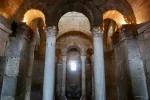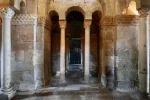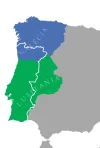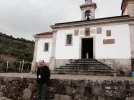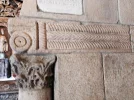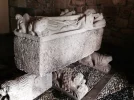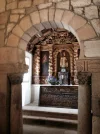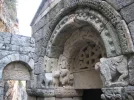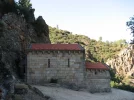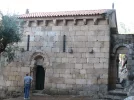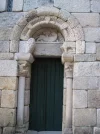- Time of past OR future Camino
- Some in the past; more in the future!
I spent a few days in and around Braga in northern Portugal this week and discovered an amazing medieval chapel that should be more well known than it is - for example, it is not even mentioned in the Lonely Planet Portugal guidebook that I have (the 2014 9th edition). So here’s my attempt to hype it up!
São Frutuoso is a funerary chapel that was built in AD 660 by the eponymous bishop of Braga, north of the historic centre of town. It was later modified in the high Middle Ages and experts debate whether the dominant architectural features date from the original Visigothic building or the Mozarabic modification. In any case, the remaining original aspects make it the most important pre-Romanesque Christian building in Portugal.
It’s a small chapel on a Greek cross floorplan with eight of 22 columns extant (six of the eight with their medieval capitals). It’s wonderfully atmospheric and to be there all by ourselves for about 45 minutes was incredible and easily the highlight of Braga for me. The Bom Jesus sanctuary nearby is much more famous but not nearly as interesting for me as an amateur medievalist.
I put São Frutuoso in the same category as Wamba on the Camino de Madrid, given the Visigothic-Mozarabic architectural features of both structures. Wamba is more impressive because of its ossuary and frescoes, but São Frutuoso is still wonderful in its own right.
Braga, the third largest city in Portugal, is not on the main CP but easily reachable by train from Porto. It’s also the starting point for an alternative CP known as the Braga Way. We saw quite a few camino arrows, including at São Frutuoso.
São Frutuoso is a funerary chapel that was built in AD 660 by the eponymous bishop of Braga, north of the historic centre of town. It was later modified in the high Middle Ages and experts debate whether the dominant architectural features date from the original Visigothic building or the Mozarabic modification. In any case, the remaining original aspects make it the most important pre-Romanesque Christian building in Portugal.
It’s a small chapel on a Greek cross floorplan with eight of 22 columns extant (six of the eight with their medieval capitals). It’s wonderfully atmospheric and to be there all by ourselves for about 45 minutes was incredible and easily the highlight of Braga for me. The Bom Jesus sanctuary nearby is much more famous but not nearly as interesting for me as an amateur medievalist.
I put São Frutuoso in the same category as Wamba on the Camino de Madrid, given the Visigothic-Mozarabic architectural features of both structures. Wamba is more impressive because of its ossuary and frescoes, but São Frutuoso is still wonderful in its own right.
Braga, the third largest city in Portugal, is not on the main CP but easily reachable by train from Porto. It’s also the starting point for an alternative CP known as the Braga Way. We saw quite a few camino arrows, including at São Frutuoso.



